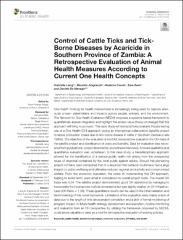| dc.contributor.author | Laing, Gabrielle | |
| dc.contributor.author | Aragrande, Maurizio | |
| dc.contributor.author | Canali, Massimo | |
| dc.contributor.author | Savić, Sara | |
| dc.contributor.author | De Meneghi, Daniele | |
| dc.date.accessioned | 2019-12-17T13:56:58Z | |
| dc.date.available | 2019-12-17T13:56:58Z | |
| dc.date.issued | 2018 | |
| dc.identifier.citation | Laing G, Aragrande M, Canali M, Savic S and De Meneghi D (2018) Control of Cattle Ticks and Tick-Borne Diseases by Acaricide in Southern Province of Zambia: A Retrospective Evaluation of Animal Health Measures According to Current One Health Concepts. Front. Public Health 6:45. doi: 10.3389/fpubh.2018.00045 | en_US |
| dc.identifier.issn | 2296-2565 | |
| dc.identifier.uri | https://repo.niv.ns.ac.rs/xmlui/handle/123456789/219 | |
| dc.description.abstract | One health thinking for health interventions is increasingly being used to capture previously
unseen stakeholders and impacts across people, animals, and the environment.
The Network for One Health Evaluation (NEOH) proposes a systems-based framework to
quantitatively assess integration and highlight the added value (theory of change) that this
approach will bring to a project. This case study will retrospectively evaluate the pioneering
use of a One Health (OH) approach during an international collaboration (satellite project
to tackle production losses due to tick-borne disease in cattle in Southern Zambia in late
1980s). The objective of the evaluation is twofold: retrospective evaluation the OH-ness of
the satellite project and identification of costs and benefits. Data for evaluation was recovered
from publications, project documents, and witness interviews. A mixed qualitative and
quantitative evaluation was undertaken. In this case study, a transdisciplinary approach
allowed for the identification of a serious public health risk arising from the unexpected
reuse of chemical containers by the local public against advice. Should this pioneering
project not have been completed then it is assumed this behavior could have had a large
impact on public wellbeing and ultimately reduced regional productivity and compromised
welfare. From the economic evaluation, the costs of implementing this OH approach,
helping to avoid harm, were small in comparison to overall project costs. The overall OH
Index was 0.34. The satellite project demonstrated good OH operations by managing to
incorporate the input across multiple dimensions but was slightly weaker on OH infrastructures
(OH Ratio = 1.20). These quantitative results can be used in the initial validation and
benchmarking of this novel framework. Limitations of the evaluation were mainly a lack of
data due to the length of time since project completion and a lack of formal monitoring of
program impact. In future health strategy development and execution, routine monitoring
and evaluation from an OH perspective (by utilizing the framework proposed by NEOH),
could prove valuable or used as a tool for retrospective evaluation of existing policies. | en_US |
| dc.description.sponsorship | This article is based upon work from COST Action (Network for Evaluation of One Health, TD1404), supported by COST (European Cooperation in Science and Technology). | en_US |
| dc.language.iso | en | en_US |
| dc.subject | public health | en_US |
| dc.subject | environmental impact | en_US |
| dc.subject | economic evaluation | en_US |
| dc.subject | OH index | en_US |
| dc.subject | one health | en_US |
| dc.title | Control of cattle ticks and tick-borne diseases by acaricide in Southern Province of Zambia: a retrospective evaluation of animal health measures according to current one health concepts | en_US |
| dc.title.alternative | Frontiers in Public Health | en_US |
| dc.type | Article | en_US |
| dc.doi | 10.3389/fpubh.2018.00045 | |

